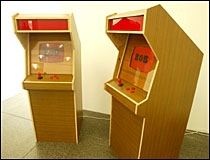By Andrew Clifford
Review of the exhibition Gameboy by Sean Kerr. Exhibited at Michael Lett Gallery, July 2005.
Although Sean Kerr’s work often pays cheeky homage to the icons of art history, he is coy about citing specific influences. Whether he is surfing on fountains, taking potshots at the macho world of early New Zealand abstraction or transforming Don Binney’s bird paintings into interactive web-art, he prefers to see these as references rather than buying into any particular legacy.
“I wouldn’t say any artist was a big influence,“ Kerr says. “I’m drawing more from popular culture than anything else – it’s much more interesting.“
The peculiarities of computer culture are an important aspect of Kerr’s work. His exhibition at Michael Lett recalls an earlier age of electronics, pre-Playstation, when gaming took place at video game parlours – smoky dens of iniquity where idle childhoods were spent shoulder-to-shoulder around rows of coin-gobbling machines.
“My one in Wainui was part of a fish-and-chip place,“ Kerr says. “It stank of fat and all the machines were greasy and squashed up.“
And when he was at art school, Kerr spent five years helping run an Auckland video-game parlour.
For his Gameboy exhibition he has built a pair of retro-game consoles loaded with his own software which features the simple, pixelated characters of yesteryear.
The game also contains references to earlier works, including last year’s veneer mountain, based on the simplified geometries of 3D modelling, and a cartoon eyeball, which has been a recurring motif.
Whether or not this refers to the cliche eyes that peer around the room from behind paintings in cartoons or to the ubiquitous stick-on googly eyes of craft art and stuffed animals, there is an unmistakable kooky quality. “The kookiness side is a big thing and it goes with my weird humour and that sort of comes out in the work,“ he says.
Although Kerr spends hundreds of hours developing some of his work, there is a deceptively simple lo-fi look that reduces video games to the basic building blocks of pixels and carpentry. “The game is very hand-made and it is very crude. The cabinets – they’re not highly finished Playstations or anything like that.“
The exhibition also features a pair of digital prints displaying the remnants of two 3D characters that have exploded.
These are not the illusionistic, gory remains common to contemporary games. Kerr’s carnage recalls a more innocent – and probably more accurate – era when computer characters disintegrated in a shower of pixelated parts rather than creating the illusion of a bloody mess.
Another pair of prints shows a mirrored image of a stag, built up from small green blocks.
“It is like a typical game structure where you build it up in tiles and there’s a lot of repeating images,“ says. “A lot of the time they flip the image to make it seem like a bigger landscape. I like that efficient use of format.“
The source of the image was similarly electronic and lo-tech. “They are images off the internet. Crappy images which I silhouetted and tiled. I generate a lot of stuff off the internet.
“The Google image search is a great inspiration. It’s a great, great resource for thinking up ideas and looking at your contemporary culture. I want to build an idea machine which would probably use the Google image search as a part of it.“
A particularly funny work from last year showed Kerr in bright boardshorts surfing on top of the Auckland Domain duckpond fountain. Possibly a witty reference to Marcel Duchamp’s famous urinal, a still from this video piece won the Still Image Award in the inaugural Vodafone Digital Art Awards earlier this year.
Kerr, who prefers not to be pigeonholed as a digital artist, is glad to see Vodafone promoting media art.
“It’s good that they’re interested in supporting digital arts but I’m very critical of what digital arts are,“ Kerr says.
“I am quite critical of places that are setting up just for digital media. I don’t think it’s the right way to go because you think of the Govett Brewster and all the major galleries that are supporting new media work as well as everything else.“
Kerr says separating art that is made digitally from other work runs the risk of ghetto-ising it.
“I think they should just call it an art form. It doesn’t matter what medium it’s in. It’s just backward thinking. You should celebrate any art form.“
